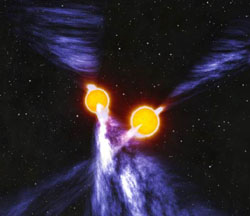An Unconventional Birth

Neutron stars are supposed to arise violently from supernova explosions, according to theory. But in the 11 February PRL, an analysis of a pair of whirling neutron stars–ultradense spheres about 20 kilometers wide–indicates that one of them may have formed directly from a small object called a white dwarf. This peaceful birth fascinates astrophysicists, but critics think the evidence doesn’t yet rule out the standard supernova picture.
The neutron star pair made headlines a year ago as the first “double pulsar” ever observed. Both objects whip beams of radiation into space as they spin. Radio telescopes see the neutron stars pulse at precise intervals and detect eclipses as one pulsar swoops in front of the other.
Astrophysicists agree that the pair began as two large stars orbiting close together. In the commonly accepted model, each star blew up and forged a neutron star, and the binary pair was tight enough to remain bound after the explosions. Because a supernova explosion is usually somewhat lopsided, the star normally shoots through space, often at hundreds of kilometers per second. So most neutron stars are propelled at a high speed far from the plane of our Milky Way galaxy, where the majority of stars reside.
But that’s not what studies reveal for the binary pulsar, say astrophysicists Tsvi Piran and Nir Shaviv of Hebrew University in Jerusalem. They calculated that, if the newest pulsar had arisen from a supernova, even a minimal explosion would have “kicked” the binary in a random direction at 120 kilometers per second or more. However, the system’s motion across the sky appears far more leisurely: just 20-30 kilometers per second, according to new results. Moreover, the pulsars are just 150 light-years from the galaxy’s plane, not far from their probable birthplace tens or hundreds of millions of years ago.
The contradictions suggest a tantalizing alternative, says Piran: A lower-mass white dwarf could collapse into a neutron star without exploding. A white dwarf–the Earth-sized remnant of a medium-mass star–forms without a supernova and can hold about 1.4 times the mass of our sun before gravity crushes its atoms. If the newborn dwarf was slightly more massive than that, the outward pressure of its intense heat could hold off the inward pressure of gravity for millions of years, Piran says. Then, when it cooled, a “quiet” collapse could have formed the pulsar and expelled little mass. “We argue that it is extremely improbable to get this small velocity in any other way,” says Piran, who is on leave at the California Institute of Technology in Pasadena. “Whatever was there [before the neutron star], it was very light.”
That claim intrigues other researchers, but they say the case is not settled. The binary might actually race toward or away from us at high speed, but the system is far too faint for astronomers to discern that velocity. Rather, they can only deduce its two-dimensional motion across the plane of the sky, notes astrophysicist Vicky Kalogera of Northwestern University in Evanston, Illinois, although Piran believes a high velocity along our line of sight is quite unlikely. Kalogera also says Piran and Shaviv failed to account for the long-term curving orbit of the system within the rotating Galactic disk, which could alter the pulsar pair’s apparent speed and direction of motion today. Astrophysicist Steinn Sigurdsson of Pennsylvania State University in University Park concurs and raises another caveat: About 10 percent of observed pulsars linger near their birthplaces, scarcely moved by their explosive origins. “We don’t really understand pulsar kicks,” he says.
–Robert Irion
Robert Irion is a freelance science writer based in Santa Cruz, CA.
More Information
double pulsar news and animation from Jodrell Bank Observatory


